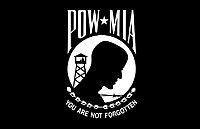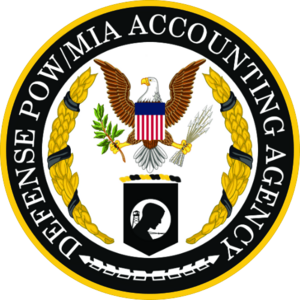National League of Families POW/MIA flag facts for kids
 |
|
| Name | National League of Families POW/MIA flag |
|---|---|
| Use | Other |
| Proportion | 9:14 |
| Adopted | January 1972 |
| Design | A silhouette of a prisoner of war (POW) before a guard tower and barbed wire in white on a black field. "POW/MIA" appears above the silhouette and the words "You Are Not Forgotten" appear below in white on the black field. "MIA" stands for "missing in action." |
| Designed by | Newt Heisley |
The National League of Families POW/MIA flag, often called the POW/MIA flag, is a special symbol. It was created in 1972. This flag shows support for American soldiers, airmen, and sailors. It especially honors those who were prisoners of war (POW) or missing in action (MIA) during the Vietnam War.
In 2019, a law was passed called the National POW/MIA Flag Act. This law requires the POW/MIA flag to fly on certain government buildings. These include the U.S. Capitol Building. It must fly on all days the U.S. flag is flown.
Contents
History of the POW/MIA Flag
The POW/MIA flag has an important history. It began during the Vietnam War. In 1971, Mary Hoff suggested creating a symbol. Her husband, Lt. Commander Michael Hoff, was MIA. Mary was part of the National League of POW/MIA Families. This group helps families of missing service members.
The flag was made for the National League of Families. The U.S. Congress officially recognizes it. It stands for the nation's promise to find out what happened to Americans still missing. This helps bring peace to their families. Evelyn Grubb, whose husband was a POW, helped make the flag popular. She worked hard to get it used by the government and other groups.

The POW/MIA flag first flew over the White House in September 1982. In 1989, a flag that had flown over the White House was placed in the U.S. Capitol building. This showed strong support from Congress. In 1990, Congress passed a law. This law officially recognized the flag. It called the flag a symbol of the nation's care for missing Americans. Over time, the flag became a symbol for POW/MIAs from all U.S. wars.
In October 2017, Maryland state buildings started flying the flag. Then, in November 2019, the National POW/MIA Flag Act became law. This law made it mandatory to fly the flag at many federal places. Before this law, the flag was only flown on specific holidays. These included Armed Forces Day, Memorial Day, and Veterans Day.
The flag reminds people that some service members are still unaccounted for. The Defense POW/MIA Accounting Agency works to find these missing Americans. As of October 2020, 1,585 Americans were still unaccounted for. The agency continues to investigate these cases.
Design of the POW/MIA Flag
The POW/MIA flag has a clear design. It shows a dark silhouette of a prisoner of war (POW). Behind the silhouette, you can see a guard tower and barbed wire. All these images are white on a black background.
Above the silhouette, the letters "POW/MIA" appear in white. Below it, the words "YOU ARE NOT FORGOTTEN" are also in white. Newt Heisley created the original design for the flag. He was asked to design it in 1971. Mary Hoff, a member of the National League of Families, requested the flag. She wanted a symbol for missing service members.
How to Display the POW/MIA Flag
There are rules for how the POW/MIA flag should be displayed. If it's on the same flagpole as the U.S. flag, it must fly directly below it. It also should not be larger than the U.S. flag. If the flags are on separate poles, the U.S. flag should always be to the right. This means it's on the viewer's left side.
On six national holidays, Congress requires the flag to be displayed. It is usually flown right below or next to the U.S. flag. In the U.S. Armed Forces, dining halls often have a special table. This single table and chair are draped with the POW/MIA flag. It's a symbol for the missing, hoping for their return. Veterans' groups also display the flag at their meetings.
The National POW/MIA Flag Act makes sure the flag is displayed at many locations. It must be flown whenever the U.S. flag is displayed there. These places include the U.S. Capitol and the White House. Other locations are the World War II Memorial, the Korean War Veterans Memorial, and the Vietnam Veterans Memorial. Every national cemetery and many government offices also fly the flag. This includes offices for the Secretaries of State, Defense, and Veterans Affairs. It is also flown at military bases, VA medical centers, and post offices.
See also
- List of black flags
- List of flags of the United States


